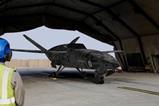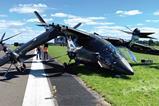Textron Aviation Defense and partner Leonardo believe their offer of the latter’s M-346 Master and integrated training system (ITS) will offer the US Navy (USN) a proven, low-risk solution as the service gears up to replace its aged fleet of Boeing T-45 Goshawk jet trainers.
While Italy’s Leonardo will supply the aircraft – to be assembled at an undisclosed US location – Wichita-based Textron Aviation is leading the bid for the navy’s Undergraduate Jet Training System (UJTS) requirement as prime contractor, leveraging its “deep training relationship” with the USN, says Tom Webster, the defence unit’s vice-president of sales.

Webster points out that multiple generations of naval aviators have trained on products from Beechcraft – a Textron Aviation brand – including the T-34 Mentor, T-6 Texan and T-44 Pegasus, with the King Air 260-based T-54A to enter service shortly. “The only thing we have not done is the jet training piece,” he says.
But following an initial agreement last year, Textron Aviation is “delighted” to be able to offer the M-346 to the navy, he says, noting that it is a “not only a proven platform but a proven trainer of students going to the [Lockheed Martin] F-35, [Eurofighter] Typhoon and [Boeing] F-15” thanks to its use by Israel, Poland and Singapore.
“We know it can deliver the kind of trained aviator the navy needs,” he adds. “It’s a low-drama, proven-capability solution with real data backing up the claims we make.”
He contrasts the M-346’s maturity with the “developmental” nature of its rivals for the UJTS contest – Boeing’s T-7A Red Hawk and the Lockheed/Korea Aerospace Industries T-50.
Leonardo’s proven ITS – which blends live, virtual and constructive training – provides another advantage, he argues.
Despite the jet’s Italian heritage, Webster is confident that US rules around domestic content are easily addressed. With the jet to be assembled in the USA “the biggest piece of US content that remains to be worked” is the type’s Honeywell F124 engines. But with their assembly moving from Taiwan to Phoenix, that particular concern has been addressed, he says.
“It’s not even close for us; it’s not on the line. We are not concerned about this, we are well into the Made in America piece and we’ll be doing the final assembly line here in the US.”
Details of the “final assembly construct” will be worked out over the coming months, but engineers from Textron Aviation have recently visited Leonardo’s M-346 factory in Venegono Superiore “to get a thorough understanding of the production line”, adds Webster.
That “mature, running, hot assembly line” means that if the navy requires an accelerated delivery timeline, “Leonardo can turn M-346s out of Venegono today” while the US plant is still being stood up. “I believe that for both our competitors that would offer a bit of a challenge,” he says.
In the requests for information (RFIs) so far released by the navy, there has been no indication that the UJTS platform will be required to carry out carrier landings, a role currently performed with the Goshawk.
On that basis, the Textron Aviation/Leonardo team has not carried out any engineering analysis of whether the M-346 could be adapted to the role.
“Since they haven’t asked us yet, we are not doing a lot of advanced engineering to deal with hypotheticals,” says Webster.
“One of things that RFIs do is steer us down a particular road as far as engineering goes. Part of what that has steered us towards us with the M-346… is to have a field carrier landing practice-capable airplane but not necessarily one that is designed to go to the aircraft carrier,” adds Steve Helmer, flight-test and demonstration pilot for Textron Aviation Defense.
Should the navy opt for a carrier-capable platform “that would require a non-trivial engineering effort to assess the airplane and what changes we would need to make”, he says.
Through UJTS, the navy intends to acquire 149 new aircraft, including an initial tranche of four engineering and manufacturing development examples. First deliveries are envisaged in the USN’s 2026 fiscal year, according to the service’s latest budget plan.
























